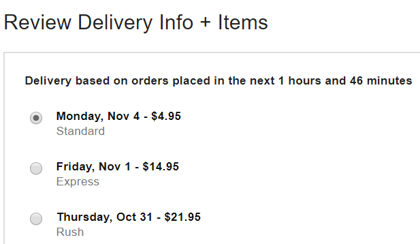As recently as just a couple of years ago, the term “delivery experience” was little more than an industry buzzword, often prefaced by “the Amazon effect” or “the e-commerce boom.” However, delivery experience has rapidly become a strategic focal point for many companies, and with good reason. Consumers expect a consistent, transparent, and frictionless delivery experience, and companies that fail to meet these expectations risk losing customer loyalty and ultimately revenue.
A recent report published by Project44 titled “The Delivery Economy & The New Customer Experience” had this to say regarding the growing importance of the delivery experience.
“Consumers are no longer just buying a product, they’re buying an experience. Fast, inexpensive shipping that provides consumers precise visibility into the process is becoming more influential than core purchasing elements—like price, value, and customer service.”
With this in mind, below are 10 tips to help build a winning 2020 delivery experience strategy.
1. Re-assess your shipping strategy. Are the shipping options provided to your customers meeting their expectations? Are shipping options, including delivery time and cost, on par with your company’s competitive set? If the answer to either question is “No,” determine what changes are critical to improving the delivery experience and develop an implementation plan to address your customers’ needs.
2. Provide succinct, simply stated shipping options. Providing a positive delivery experience begins well before a package is shipped, let alone delivered. Whether presented as static content on a Shipping/FAQ page or dynamically displayed on PDPs, shipping options should be simple, clean, and easy to understand. The last thing you want is to have a customer become confused, frustrated, and abandon before even reaching checkout. Whether you offer a flat rate by shipping option or free with a threshold (or both), make sure the options are simply presented in a table or graphic that is easy to comprehend.
3. Clearly communicate an estimated delivery date (EDD). It is no longer sufficient to provide the standard five-to-seven-day delivery window and show an EDD of seven business days (gasp) in checkout for all customers. EDDs calculated specific to a customer’s delivery address are table stakes. Present the EDD in line with delivery options in checkout to ensure the customer has a clear understanding of when she can expect to receive her order (done well by Urban Outfitters below). 
4. Provide a post-purchase delivery experience solution. What kind of experience do you think a customer has if she sees “Label created, not yet in system” when clicking on the link in her ship confirmation email? (Hint: It’s probably not a good one). Post-purchase delivery experience requires a solution to communicate with customers, instead of requiring them to track packages (which, as a parcel nerd, I don’t even like to do). Whether you partner with someone or develop something internally, it is imperative to provide your customers with a solution which informs them of tracking or status updates and facilitates customer interaction.
5. Leverage parcel data to enhance delivery predictability. While standard TMS functionality, such as using carrier-provided transit days, may be sufficient to calculate an estimated delivery date, an opportunity exists to leverage parcel delivery data to better inform carrier routing decisions and provide a more consistent delivery experience. Consume parcel delivery data to measure a percentage of packages delivered by day, across carrier services, ship day of the week, and destination ZIP Code. Set acceptable delivery performance thresholds within a TMS and incorporate this logic into the package routing decision process.
6. Implement a delivery experience management solution. Failure to identify delivery issues before they affect the delivery experience is a good way to lose customers. Many options exist to identify delivery exceptions and communicate the issue to the customer, ranging from a manual process of using carrier tracking tools, CRM software and email, to parcel visibility solutions designed specifically to solve delivery experience issues. Engage a cross-functional team to assess your company’s current process and areas of opportunity and determine the solution that best addresses short-term needs and enables flexibility to adapt to the changing needs of your customers.
7. Evaluate shipping costs and budget accordingly for planned changes. Whether handled internally, partnering with a parcel audit and analytics provider, or a combination of both, perform a detailed cost analysis to ensure shipping strategy initiatives can be supported according to established metrics (e.g. shipping cost per unit or shipping cost as a percentage of revenue). If shipping costs are too high, now is the time to re-negotiate your parcel agreements, as well as engage prospective carriers, to affect the bottom line in Q1.
8. Explore alternatives to the “Big Two” carriers. Shippers must think outside the Brown and Purple boxes to fully assess carrier delivery options. Collectively, carriers such as the USPS, postal consolidation carriers (DHL eCommerce, Pitney Bowes), regionals (Lasership, UDS, OnTrac), and final mile delivery providers (Deliv, Need It Now Delivers) remain an underutilized asset in the e-commerce delivery space. While it may not be easy to break away from the revenue and volume commitments often required from UPS and FedEx, remaining “locked in” to one of these carriers simply limits your options. Engage with alternate carriers and, if needed, leverage third-party consultants to assist with evaluating options, assessing contracts and rates, and selecting delivery partners that align to your shipping strategy.
9. Test, Test, Test. Adding capabilities to enhance the delivery experience doesn’t have to be an all-or-nothing proposition. Utilize a brand, customer segment, product, or order type to test different shipping and delivery options. Explore and test new carriers and/or services at a small scale to ensure they are properly vetted prior to fully implementing. Test, measure results, iterate, and repeat until the desired results are achieved.
10. Personalize the delivery experience. If you really want to provide an elevated delivery experience, personalization is critical. A one-size-fits-all approach is simply not enough in an environment where customers have more access to data, require precise visibility to their order, and demand the ability to influence the delivery. If free next-day delivery can be offered to a customer because she lives 50 miles from your distribution center, make it available to influence her purchasing decision. There is only so much value to be gained from the “surprise and delight” approach of providing a generic estimated delivery date, only to deliver three days “early.” Just delight your customer and incent her to buy.
While offering a compelling delivery experience may be complex and challenging to design, implement, and execute, those who are able to do so will have an edge over the competition and be well-positioned for success in 2020.
Nate Skiver is the founder of Level Playing Field Spend Management, a parcel consulting company which provides value for its clients through creating parcel shipping programs which reduce expense, while delivering a positive customer experience. Prior to founding Level Playing Field, he spent more than 15 years focused on building, executing, and managing parcel transportation programs for leading global apparel companies. He can be reached at nate@lpfspendmanagement.com.
This article originally appeared in the January/February, 2020 issue of PARCEL.
















